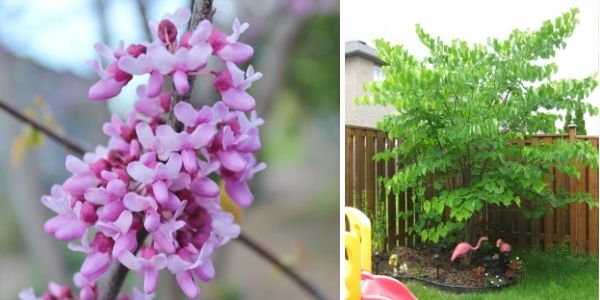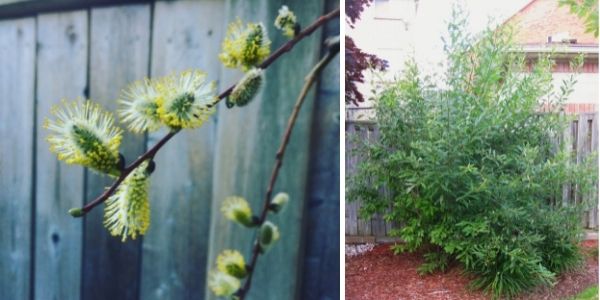Soak up the first signs of spring while enhancing habitat for local pollinators with these buzzing species:
Eastern Redbud (Cercis canadensis)
Looking to turn your yard into a pollinator hot spot? The small, bright, pink-purple flowers of the eastern redbud emerge in clusters on bare branches in early spring – even before their leaves! All sorts of bees, butterflies and birds are attracted to the early pop of colour, including sweat bees, digger bees, zebra swallowtails and ruby-throated hummingbirds.

The eastern redbud is a large growing shrub with heart-shaped leaves, which turn a stunning golden yellow in the fall. It grows best in partial to full shade and prefers a well-drained loamy to sandy soil.
Red Maple (Acer rubrum)
Want your yard to stun year-round? One of the first trees to produce flowers in the spring is the red maple, which has small, bright red flowers that grow in hanging clusters. These flowers emerge before the leaves and offer lots of nutritious pollen and nectar for mason bees, bumblebees and more! This early-season food source helps stimulate brood rearing and colony building.

As its name implies, the red maple sports a scarlet tinge, from its stalks and twigs to its flowers, fruit and leaves. This medium-growing deciduous tree will flourish best in an area with loamy to sandy soil and full to partial sun.
Pussy Willow (Salix discolor)
Looking for a species that will give you that warm, fuzzy feeling? The fuzzy catkins (clusters of flowers) of the pussy willow emerge in late winter, bursting into clusters of small, bright yellow male flowers and long, yellowish green female flowers in early spring (on separate shrubs). These pollen-rich blooms offer one of the earliest food sources for pollinators, making this species a favourite among bumblebees, swallowtails and ruby-throated hummingbirds, alike.

Pussy willow is a large-growing deciduous shrub that can tolerate a range of soils. Plant this species in a spot with lots of sun to watch its canopy spread with long, green leaves that turn yellow in the fall. (Note: LEAF cannot guarantee a male or female shrub).
Serviceberry (Amelanchier laevis)
Are you ready to bring on the butterflies (and the birds)? The serviceberry signals the beginning of spring with its showy clusters of white flowers. They emerge before the foliage and are only here for a short – but sweet – while (about 2 weeks). Their mildly fragrant flowers attract a range of butterflies, including Canadian tiger swallowtails and coral hairstreak as well as our feathered friends – Baltimore orioles.

In June, serviceberry flowers give way to small, round reddish berries that look and taste like sweet blueberries and are a favourite for local birds! You can plant this small growing deciduous tree (or shrub) in a range of soils, but make sure it gets some sun.
Plant these early spring blooms for less through our subsidized Backyard Tree Planting Program! Check out our Homeowners page to get started on tree planting and our Shrubs, Garden Kits and pawpaws page to order shrubs.
Meandra is the Marketing and Communications Coordinator at LEAF.
The #BackyardBiodiversity campaign is a partnership initiative with the Toronto Wildlife Centre and is supported by Ontario Power Generation.
LEAF offers a subsidized Backyard Tree Planting Program for private property. The program is supported by the City of Toronto, the Regional Municipality of York, the City of Markham, the Town of Newmarket, the Regional Municipality of Durham, the Town of Ajax, the City of Oshawa, the City of Pickering, the Township of Scugog, the Town of Whitby, Ontario Power Generation, Ontario Trillium Foundation and GrandTrees/Canadian Trees For Life.
